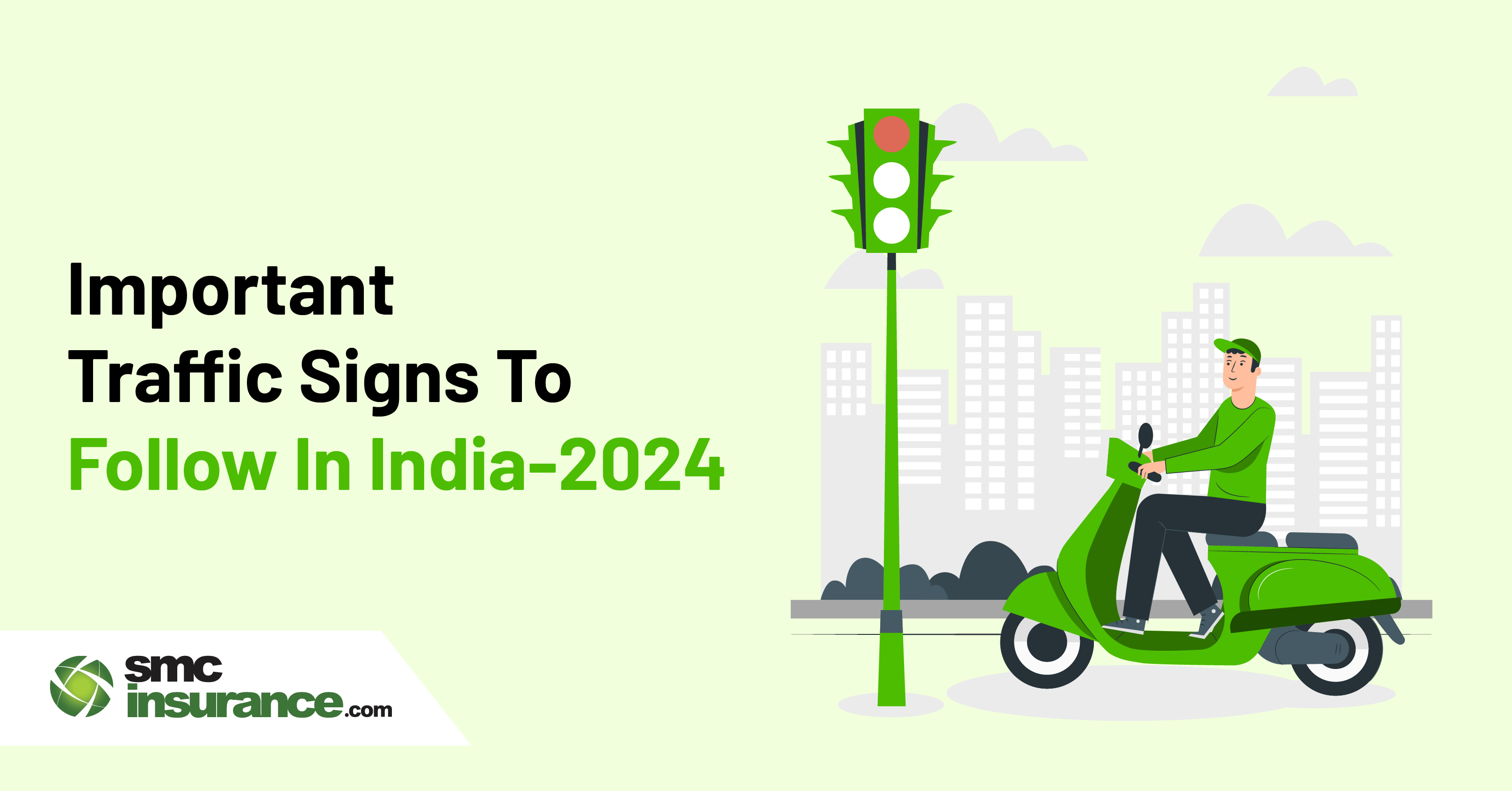When driving on Indian roads, you'll encounter various signs along the way. These signs serve a crucial purpose, helping ensure safety and providing important information to drivers. They indicate when to stop, where parking is allowed, and which lanes are designated for different types of vehicles.
In the dynamic landscape of Indian traffic, these signs play a pivotal role in maintaining order and safety. They serve as information, conveying crucial messages to drivers, pedestrians, and cyclists alike. Whether it's a vibrant red stop sign commanding attention at an intersection or a subtle arrow indicating a change in direction, each sign serves a specific purpose, contributing to the overall safety and efficiency of the transportation system. Having said this, also keep in mind to buy insurance to secure your ride.
It is essential for motor vehicle drivers to grasp the significance of various traffic signs in ensuring safe driving practices. Any person intending to drive on Indian roads must possess a valid driving license and demonstrate a thorough understanding of traffic signs and regulations. To obtain a driving license, applicants undergo a comprehensive driving license test, which assesses their familiarity with traffic signs and signals.
Why do we need traffic signs?
- Parking Regulations: Traffic signs inform drivers about parking restrictions, indicating whether parking is permitted in certain areas or prohibited altogether.
- Lane Discipline: Traffic signs delineate lanes for different types of vehicles, such as heavy trucks, buses, and cars.
- Safety Alerts: Traffic signs serve as early warning systems, alerting drivers to potential hazards ahead, such as sharp curves, pedestrian crossings, or construction zones.
- Navigation Guidance: Traffic signs provide valuable guidance on directions, indicating the routes drivers should take to reach their destination. Whether it's a highway exit sign or a street nameplate, these signs help drivers navigate unfamiliar roads with confidence, reducing the risk of getting lost or taking wrong turns.
What Are The Traffic Signs In India?
Mastering traffic signs is essential for staying safe on the road. These signs convey fundamental rules and regulations of road safety through straightforward graphics that can be quickly understood. For instance, anyone seeking a driving license must have a thorough understanding of these signs to pass the theoretical portion of the driving test. Let's explore the different types of traffic signs and symbols used on Indian roads.
 Source : blog.fleetable.tech
Source : blog.fleetable.tech
Different Types of Traffic Signs In India
Mandatory Traffic Signs
In India, adhering to all traffic signs is imperative. However, among them, mandatory signs hold utmost importance and must be strictly followed. Disregarding these signs may result in penalties, as outlined by the Roadways and Traffic Department of India.
These signs ensure the smooth flow of traffic and enhance pedestrian safety by conveying critical information such as speed limits, no parking zones, and restricted areas. Let's take a look at the mandatory traffic signs -
- Stop: This sign requires drivers to come to a complete halt upon sighting it.
- Straight Prohibitor No Entry: Denotes a restricted area where entry is prohibited.
- Give Way: Indicates that drivers should yield to oncoming traffic, particularly from the right.
- Pedestrian Prohibited: Signals that the area is off-limits for pedestrians.
- Horn Prohibited: Indicates areas where honking is restricted.
- No Parking: Restricts parking in designated areas.
- No Stopping Or Standing: Prohibits vehicles or individuals from stopping or standing at marked locations.
- Speed Limited: Mandates adherence to specified speed limits.
- Right Hand Curve: Warns drivers of a right-hand curve ahead.
- Left Hand Curve: Warns drivers of a left-hand curve ahead.
- Right Hair Pin Bend: Alerts drivers to a sharp right turn ahead.
- Left Hair Pin Bend: Alerts drivers to a sharp left turn ahead.
- Narrow Road Ahead: Warns drivers of a narrow road up ahead.
- Narrow Bridge: Indicates the presence of a narrow bridge on the road ahead.
- Pedestrian Crossing: Signals pedestrians to cross the road.
- School Ahead: Warns drivers of a school nearby.
- Roundabout: Indicates the presence of a circular intersection.
- Dangerous Dip: Alerts drivers of a sharp dip in the road.
- Hump or Rough: Warns drivers of a hump or rough patch ahead.
- Barrier Ahead: Indicates the presence of a barrier ahead, such as toll booths.
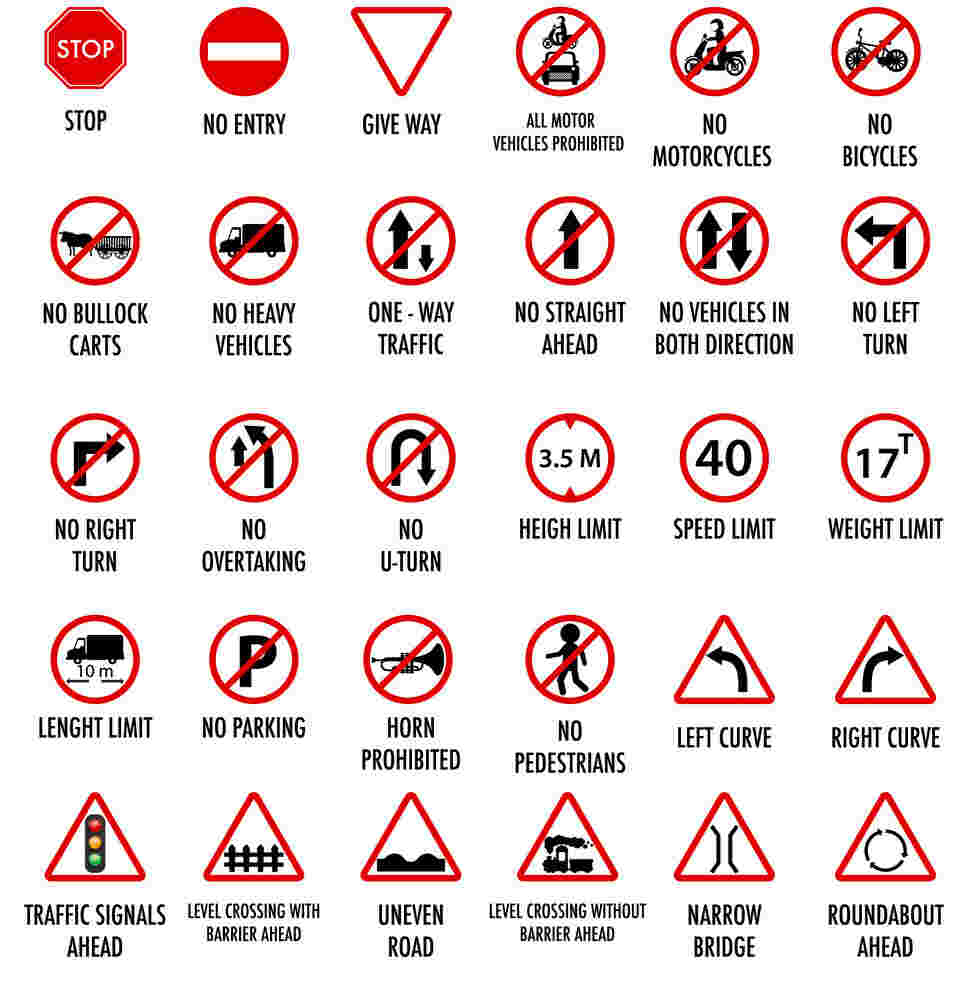 Source : godigit.com
Source : godigit.com
These mandatory traffic signs are essential for ensuring road safety and smooth traffic flow, and it's vital for all drivers to understand and adhere to them diligently.
Cautionary Traffic Signs
Among the multitude of traffic signs in India, cautionary signs stand out as silent sentinels, warning drivers of potential hazards ahead. These signs are not to be taken lightly, as they serve as vital alerts for safe navigation on the bustling thoroughfares.
Ever wondered just how many cautionary signs there are in India? Well, the answer is a whopping 40. Each of these signs holds valuable information, urging drivers to take necessary precautions and adjust their speed accordingly. They are given below.
- Right Hand Curve: A gentle reminder to drivers of an upcoming right-hand curve, urging them to approach with caution.
- Left Hand Curve: Similar to its counterpart, this sign signals a left-hand curve ahead, prompting drivers to steer with care.
- Right Hair Pin Bend: Brace yourself for a sharp right turn. This sign warns of a hairpin bend, requiring drivers to navigate carefully.
- Left Hair Pin Bend: Likewise, this sign alerts drivers to a sharp left turn ahead.
- Right Reverse Bend: This cautionary sign indicates a series of reverse bends to the right, prompting drivers to anticipate twists and turns.
- Left Reverse Bend: Similarly, this sign warns of reverse bends to the left, advising drivers to prepare for winding roads.
- Steep Ascent: This sign indicates a steep ascent ahead, requiring drivers to gear down and proceed with caution.
- Steep Descent: This sign signals a steep descent, urging drivers to maintain control and use caution on the downhill slope.
- Narrow Road Ahead: This sign warns of an impending narrow road, prompting drivers to be mindful of oncoming traffic.
- Road Wideness Ahead: This sign indicates a widening road ahead, allowing drivers to anticipate increased space for maneuvering.
- Narrow Bridge: This sign alerts drivers to a narrow bridge ahead, urging them to proceed with caution.
- Slippery Road: This sign warns of slippery road conditions.
- Cycle Crossing: This sign indicates a designated area for bicycle crossing, urging drivers to be mindful of cyclists.
- Pedestrian Crossing: This sign signals a pedestrian crossing, reminding drivers to yield to foot traffic.
- School Ahead: This sign warns of a school zone ahead, urging drivers to be vigilant and watch for children.
- Men At Work: This sign indicates roadwork ahead, advising drivers to be alert for construction activities.
- Cattle: This sign warns of possible cattle on the road.
- Falling Rocks: This sign alerts drivers to the risk of falling rocks.
- Ferry: This sign indicates the presence of a ferry service ahead, guiding drivers to water crossings.
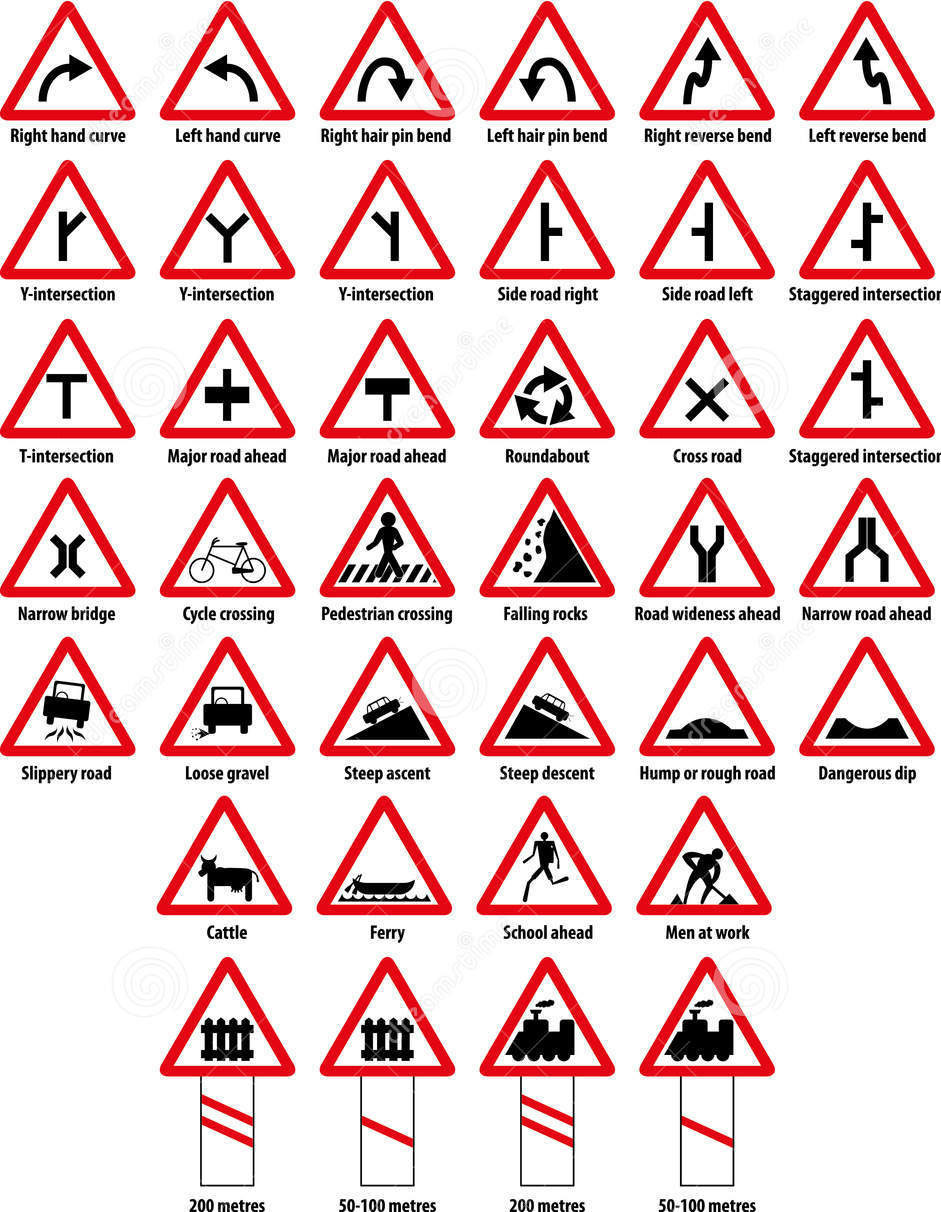 Source : dimapurpolice.in
Source : dimapurpolice.in
Informatory Traffic Signs
Informatory signs are indispensable on the road, providing drivers with vital information about nearby facilities, even if they're unfamiliar with the area's layout. These signs play a crucial role in ensuring drivers can access essential services without difficulty. Let's explore the significance of each informatory traffic sign -
- Light Refreshment: Highlights the presence of a light refreshment facility nearby, perfect for a quick snack or beverage.
- Resting Place: Indicates the availability of a resting place nearby, ideal for taking a break during long journeys.
- No Through Road: Alerts drivers that there is no exit available on the road, preventing unnecessary detours.
- No Through Side Road: Indicates the absence of a through side road on the main road, aiding drivers in navigating the road network effectively.
- Park This Side: Provides guidance on where to park the vehicle, ensuring orderly parking arrangements.
- Parking Lot Scooter and Motorcycle: Indicates the designated parking area for scooters and motorcycles.
- Parking Lot Cycle: Indicates the designated parking area for bicycles, facilitating convenient parking for cyclists.
- Parking Lot Cars: Indicates the designated parking area for cars, ensuring ample parking space for motorists.
- Public Telephone: Alerts drivers to the presence of a public telephone nearby, offering a means of communication in case of emergencies.
- Petrol Pump: Highlights the presence of a petrol pump nearby, enabling drivers to refuel their vehicles conveniently.
- Hospital: Indicates the presence of a hospital nearby, providing crucial information for accessing medical assistance when needed.
- First Aid Post: Signals the presence of a first aid facility nearby, offering immediate medical assistance in case of emergencies.
- Eating Place: Indicates the presence of an eating place nearby, such as restaurants or cafes, providing drivers with options for dining or refreshments.
 Source : blog.fleetable.tech
Source : blog.fleetable.tech
Importance Of Traffic Signs In Daily Life
Indian traffic signs play a pivotal role in our daily lives on the road, serving a multitude of crucial functions that contribute to safety, efficiency, and orderliness. Let's talk about the importance of these signs -
- Ensuring Smooth Traffic Flow: Traffic signs facilitate the smooth movement of vehicles, helping to prevent congestion and delays on the roadways.
- Preventing Accidents: By providing clear instructions and warnings, traffic signs help drivers anticipate and avoid potential hazards, thereby saving lives and preventing accidents.
- Providing Road Information: Traffic signs offer essential information about the road ahead, including upcoming turns, intersections, and hazards, enabling drivers to navigate safely.
- Preventing Road Offences: By clearly indicating rules and regulations, traffic signs help deter drivers from committing road offenses, promoting safer driving behavior.
- Aiding Navigation: Traffic signs assist drivers in navigating routes effectively, guiding them to their destinations with clarity and precision.
- Lane Discipline: Traffic signs inform drivers about the correct lanes to use, promoting orderly and disciplined driving on the roads.
- Ensuring Road Discipline: By conveying rules and regulations, traffic signs foster discipline among drivers, leading to safer and more courteous interactions on the road.
- Road Condition Information: Traffic signs provide valuable information about road conditions ahead, along with appropriate instructions, helping drivers adapt their driving accordingly.
- Warnings About Curves And Crossroads: Signs warn drivers about upcoming curves, crossroads, and other potential hazards, enabling them to navigate these situations safely.
- Alerting Presence Of Schools and Hospitals: Traffic signs indicate the presence of schools and hospitals nearby, accompanied by speed limits, ensuring the safety of pedestrians and patients.
- Marking Entry And Exit Points: Traffic signs clearly mark entry and exit points on roads, guiding drivers in and out of various areas safely.
- Identifying Parking Areas: Traffic signs designate parking areas, guiding drivers to suitable locations for parking their vehicles.
What Do The Different Traffic Signs Mean
Traffic signs are designed with distinct shapes and colors to convey specific messages quickly and efficiently to drivers, ensuring smooth and safe navigation without causing disruptions. According to the Road Traffic Management Corporation, these signs are categorized into four main groups, each serving a different purpose -
1️⃣Regulatory Signs: These signs control, command, prohibit, or reserve certain actions or behaviors on the road. They include:
- Control: Signs that regulate traffic flow, such as stop signs and yield signs.
- Command: Signs that issue direct commands to drivers, such as speed limit signs and no entry signs.
- Prohibition: Signs that indicate actions or behaviors that are prohibited, such as no parking signs and no horn signs.
- Reservation: Signs that reserve certain areas or lanes for specific uses, such as bus lanes and bicycle lanes.
2️⃣Warning Signs: These signs alert drivers to potential hazards, changes in road layout, or the direction of movement. They include:
- Road Layout: Signs that warn of changes in road layout, such as sharp curve ahead signs and roundabout signs.
- Direction of Movement: Signs that indicate the direction of movement, such as one-way signs and keep right signs.
3️⃣Guidance Signs: These signs provide guidance to drivers regarding location, route markers, and direction. They include -
- Location: Signs that indicate specific locations or destinations, such as hospital signs and airport signs.
- Route Markers: Signs that mark routes or highways, such as route number signs and kilometer markers.
- Direction: Signs that provide directional information, such as turn right signs and keep left signs.
4️⃣Temporary Signs: These signs issue temporary commands or prohibitions due to ongoing roadworks, events, or other temporary conditions. They include -
- Command: Temporary signs that issue commands to drivers, such as detour signs and road closed signs.
- Prohibition: Temporary signs that prohibit certain actions or behaviors, such as no parking signs during roadworks.
Understanding the meaning of these different traffic signs is essential for safe and efficient driving. Here's a breakdown of the different categories of road signs you might encounter while driving -
| Category |
Description |
Example |
| Regulatory: Control |
- Offers precise instructions.
|
- A circular red sign with a white bar signifies no entry.
|
| Regulatory: Command |
- Directs specific driving behavior.
|
- A blue sign featuring a taxi indicates exclusive use for taxis in that lane or area.
|
| Regulatory: Prohibition |
- Restricts certain driving actions.
|
- A round prohibition sign with a red line across an arrow prohibits right turns.
|
| Regulatory: Reservation |
- Designates vehicle-specific usage.
|
- A vertical rectangular sign depicting a bus indicates exclusive use for buses in that lane or area.
|
| Warning: Road Layout |
- Alerts about road layout changes.
|
- A triangular warning sign with a “T” warns of an upcoming T-junction.
|
| Warning: Direction of Movement |
- Notifies of upcoming road elements.
|
- A triangular sign with a bicycle warns to anticipate cyclists ahead.
|
| Temporary: Warning
|
- Notifies about temporary road conditions.
|
- A yellow sign depicting a digging man warns of upcoming construction work or accident scenes.
|
| Temporary: Prohibition
|
- Alerts about temporary driving restrictions.
|
- A yellow sign with the number “100” encircled in red signifies a temporary speed limit of 100km/h.
|
Requirements Of Traffic Signs In India
Let's look into the requirements that make these signs not just noticeable but indispensable -
✔️Purposeful Design
Every traffic sign must serve a distinct purpose, acting as a guiding factor amidst the sea of vehicles. From indicating a sharp curve ahead to marking a pedestrian crossing, each sign plays a crucial role in ensuring a smooth and safe traffic flow.
✔️Visual Allure
Imagine driving down a busy street and missing a vital sign because it blended into the background. It's not just about being visible; traffic signs should grab attention with their bold colors and clear graphics, ensuring every driver takes notice.
✔️Clarity Is Key
In the split-second decisions of the road, there's no room for ambiguity. Traffic signs must communicate their message swiftly and unmistakably. Whether it's a stop sign or a speed limit indicator, clarity ensures drivers react promptly and appropriately.
✔️Earned Respect
When traffic signs are thoughtfully designed and strategically placed, drivers learn to trust and obey them. But signs that are confusing or seem arbitrary? They're more likely to be ignored, breeding chaos instead of order.
When traffic signs are thoughtfully designed and strategically placed, drivers learn to trust and obey them. But signs that are confusing or seem arbitrary? They're more likely to be ignored, breeding chaos instead of order.
✔️Time To ReactPicture yourself approaching a busy intersection. The last thing you need is a stop sign appearing out of nowhere, leaving you slamming on the brakes. Effective traffic signs give drivers ample time to react, positioned strategically for maximum visibility and response time.
What Are the Functions of Traffic Signs in India
There are many functions of traffic signs in India. They are given below.
- Information Support: Traffic signs serve as beacons of information, providing drivers with essential details about the road ahead. From indicating nearby facilities to guiding drivers on the appropriate lanes to drive in, these signs offer invaluable assistance in navigating the complex road network.
- Enforcement Of Road Discipline: Upholding road discipline is essential for preventing accidents and maintaining orderly traffic flow. Traffic signs play a pivotal role in this aspect by reminding drivers of their responsibilities and encouraging adherence to traffic regulations.
- Provision Of Road Instructions: Clear and concise instructions are vital for ensuring safe driving practices. Traffic signs convey crucial instructions to drivers, informing them about upcoming crossroads, potholes, curves, and other potential hazards on the road.
- Identification Of Entry And Exit Points: Traffic signs help drivers identify entry and exit points along their route, facilitating smooth transitions between different roads and intersections. By clearly marking these points, signs contribute to safer and more efficient navigation.
- Guidance On Parking Areas: Parking can be a challenge, especially in congested urban areas. Traffic signs provide valuable information about designated parking areas, helping drivers locate suitable spots to park their vehicles safely and legally.
- Maintenance Of Speed Limits: Maintaining appropriate speeds is crucial for preventing accidents and ensuring road safety. Traffic signs inform drivers about the desired speed limits, especially near institutions or high-risk areas, reducing the risk of accidents and promoting safer driving habits.
Beyond the conventional traffic signs, India's roads boast a variety of signals and markings essential for smooth traffic management and safety. Given below are some lesser-known but equally crucial traffic signals and road markings -
Hand Signals by Traffic Police
Traffic police employ hand signals to maintain traffic flow and enhance safety. Here are some common hand signals and their meanings -
- Stop: Hand extended with the palm facing oncoming traffic, signaling vehicles to halt.
- Go: Arm outstretched with the palm facing upwards, allowing vehicles to proceed.
- Slow Down: Hand moving up and down to indicate the need for reduced speed.
- Directional Signals: Arms extended to guide drivers to move left, right, or straight.
- Turn Signals: Pointing left or right to indicate the intended direction of the turn.
- U-Turn: Circular motion of the arm signals drivers to make a U-turn.
- Follow Me: Circular motion of the arm by the traffic police directs drivers to follow.
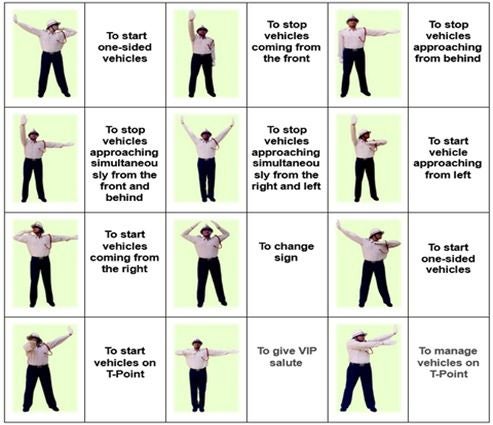 Source : cars24.com
Source : cars24.com
Hand Signals by Drivers
Drivers use hand signals to communicate with other road users, ensuring mutual understanding and safety -
- Turn Signals: Extending the left arm out of the window to indicate a left or right turn.
- Stop Signal: Palm facing downwards out of the window indicates the intention to stop.
- Hazard And Slow Down Signals: Hand movements convey warnings about hazards or the need to reduce speed.
- Overtaking Signal: Circular motion of the hand allows the vehicle behind to overtake.
- Thank You Gesture: A wave of the hand expresses gratitude to other drivers.
- Emergency And Police Signals: Repeated up-down hand motions indicate an emergency or the presence of police.
- Horn Signal: A beep alerts the driver ahead, enhancing communication in congested traffic.
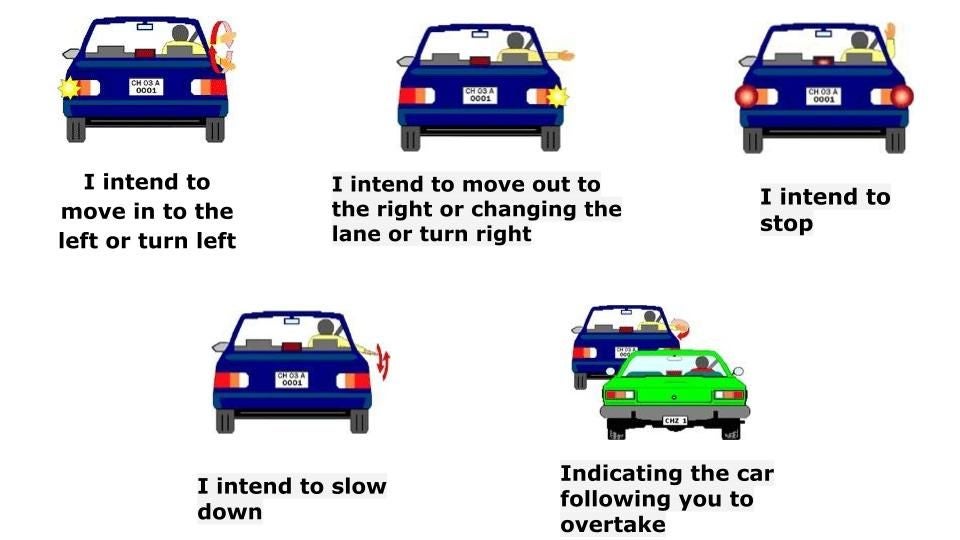 Source : cars24.com
Source : cars24.com
Road Marking or Pavement Marking Signs
Road markings play a crucial role in guiding drivers and pedestrians safely -
- Lane Separation: Broken and solid white lines delineate driving lanes and boundaries.
- Lane Restrictions: Double white lines indicate no lane changes, while yellow lines signify no passing zones.
- Pedestrian Safety: Markings designate safe pedestrian crossings, enhancing road safety.
- Directional Arrows: Arrows guide drivers on the correct path and indicate traffic flow directions.
- Parking Regulations: Zigzag lines prohibit parking, ensuring clear roadways.
- Stop Lines: Markings at intersections indicate where vehicles should halt, facilitating orderly traffic flow.
 Source : cars24.com
Source : cars24.com
Road Rage In India
The escalation of road rage incidents in India is alarming, reflecting a concerning trend of reckless behavior and aggressive driving on our roads. Triggered by stress, impatience, and frustration, road rage poses a significant threat to public safety, creating hazardous conditions for all road users.
From excessive honking to aggressive maneuvers and confrontational gestures, road rage manifests in various forms, endangering the lives of everyone involved. To mitigate this perilous phenomenon, drivers must prioritize staying calm, adhering to traffic regulations, and refraining from driving under the influence of substances.
Moreover, fostering a culture of mutual respect and consideration among drivers is crucial in preventing road rage incidents. By valuing the safety and well-being of fellow road users, we can collectively contribute to creating a safer environment for everyone.
It's imperative to recognize that road rage not only jeopardizes our own safety but also poses a grave risk to others, including pedestrians and animals. Let's pledge to exercise patience, restraint, and empathy while navigating the unpredictable roads of India, ensuring that every journey is characterized by safety and mutual respect.
Traffic Rules In India
Beyond the array of traffic signals curated by the government to ensure road safety and the seamless flow of vehicles, there exist a plethora of road safety cues and regulations that every driver must adhere to while navigating the bustling streets of India.
- Lane Discipline On Dual Carriageways: Cruise on the left side of the road to facilitate smooth passage for oncoming traffic.
- Navigating One-Way Streets: Yield to vehicles overtaking from the right.
- Executing Left Turns: Align your vehicle to the left while making left turns.
- Negotiating Right Turns: Maneuver your vehicle gradually to the right side after centering it on the road.
- Deceleration At Junctions: Mandatory to reduce speed at inter junctions, pedestrian crossings, and intersections.
- Main Road Courtesy: On unregulated thoroughfares, yield to overtaking vehicles from the right.
- Mastering Hand Signals: Employ hand signals when required -
- Slowing Down: Gently swing your right arm up and down.
- Full Stop: Vertically raise your arm to alert trailing vehicles.
- Right Turn: Extend your arm straight with the palm facing forward.
- Left Turn: Rotate your hand anti-clockwise.
- Indicating Intent With Vehicle Signals: Utilize directional indicators; deploy hazard lights in emergencies.
- Helmet Imperative: Both the driver and pillion rider on two-wheelers must don ISI-marked helmets.
- Strategic Parking Placement: Avoid parking near road crossings, hilltops, footpaths, traffic lights, pedestrian zones, building entrances, or fire hydrants.
- Visible Vehicle Identification: Ensure your vehicle's registration number remains visible at all times.
- Optimal Load Distribution: Prevent obstruction of lights by loading your vehicle appropriately to enhance road safety.
- Forward-Only On One-Ways: Prohibit reverse driving on one-way streets.
- Respecting Yellow Lines: Refrain from crossing yellow lines while overtaking.
- Lane Change Indicator Protocol: Signal lane changes on roads with designated lanes.
- Stop Line Compliance: Adhere to STOP lines painted on the road.
- Horn Moderation: Sound the horn judiciously to minimize noise pollution, avoiding excessively shrill or loud honking.
- Maintaining Safe Distances: Keep a safe distance from the vehicle ahead to prevent collisions.
- Smooth Braking Technique: Reserve sudden braking for emergencies.
- Passenger Limit Adherence: Adhere to the specified passenger limit in goods vehicles.
- Load Capacity Compliance: Avoid overloading vehicles and refrain from transporting explosives or inflammable goods in public service vehicles.
- Sharing the Road with Cyclists: Extend courtesy to cyclists on the road.
- Overtaking Etiquette: Overtake from the right side of the vehicle.
- Maintaining Speed While Being Overtaken: Maintain consistent speed when being overtaken to avoid confusion and potential accidents.
- Mirror Check Before U-Turns: Assess surroundings via rear-view mirrors and signal U-turns appropriately.
- Alertness At Yellow Lights: Exercise heightened awareness when yellow lights are illuminated.
Updated Traffic Rules In India
In a bid to bolster road safety and curb accidents, traffic regulations are continuously evolving. With the burgeoning number of vehicles crowding Indian roads daily, periodic updates to traffic laws are imperative. To this end, the government operates a dedicated research and development unit tasked with upholding road discipline for seamless traffic flow.
Recent updates to traffic regulations have been implemented across various regions, yielding varying outcomes. It asks residents to acquaint themselves with these new mandates to steer clear of any infractions.
Here are some of the latest traffic rules introduced by the research and development department -
- Mobile Phone Usage Penalties In Uttarakhand: In Uttarakhand, drivers caught using a mobile phone while driving face fines and risk having their device confiscated by traffic police for 24 hours, backed by a valid receipt.
- Driving License Seizures In Rajasthan: Violations like mobile phone use while driving in Rajasthan can lead to immediate confiscation and cancellation of the driving license at the Regional Transport Office (RTO) where it was issued, as mandated by the Jodhpur bench of the Rajasthan high court.
- Ban On Loud Silencers In Pune And Bengaluru: Cities like Pune and Bengaluru have outlawed the use of loud silencers on motorcycles, such as Royal Enfields, due to their contribution to noise pollution and adverse effects on vehicle performance and safety.
- Prohibition Of Watching Videos While Driving: Under the new Motor Vehicle Act, watching videos while driving is strictly prohibited and punishable by law, aiming to deter distracted driving incidents resulting from multitasking.
- Parking Restrictions For Rescue Vehicles: Parking in front of emergency vehicles like ambulances, fire trucks, or police vehicles is now banned, with violators facing fines starting at Rs. 2000, depending on the city.
- Fine Reissuance Protocol: A modification to existing laws stipulates that offenders cannot be fined twice for the same offense, except for overspeeding. However, if an offender misplaces the fine receipt and is caught driving in another state, the fine must be repaid.
These updated traffic regulations reflect a concerted effort to enhance road safety and foster a culture of compliance among motorists across the nation.
Summing Up!
In conclusion, the roads of India demand a thorough understanding and adherence to a myriad of traffic signs, regulations, and hand signals, all crucial for ensuring safety and orderliness. From mandatory signs dictating essential rules to cautionary signs warning of potential hazards, each element plays a vital role in facilitating smooth traffic flow and preventing accidents. Recent updates, such as penalties for mobile phone usage while driving and bans on loud silencers, underscore the government's commitment to enhancing road safety. By staying informed, practicing patience, and embracing a culture of compliance, drivers can contribute to creating safer and more harmonious driving experiences for all road users in India.
FAQs
Traffic signs serve to guide drivers in adhering to traffic laws and regulating traffic flow on specific routes. Their shape and color convey specific information to drivers.
There are three main types of traffic signs in India: Mandatory signs, cautionary signs, and informatory signs.
Warning signs are typically triangle shaped or diamond-shaped.
White diamond signs are used for non-primary roads and are often accompanied by warning and regulatory signs.
Black and yellow signs are warning signs, indicating potential hazards ahead.
Safety signs encompass four main categories: Prohibition, Warning, Mandatory, and Emergency signs.
Road markings are typically made using thermoplastic paints.
This sign indicates "No Entry," prohibiting vehicles from entering.
The primary function of traffic signs is to ensure the smooth operation of traffic on roads by providing essential information to drivers.
Yes, hand signals are crucial components of traffic signs in India, aiding in communication and safety on the roads.





